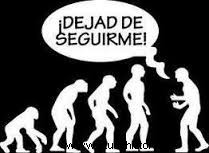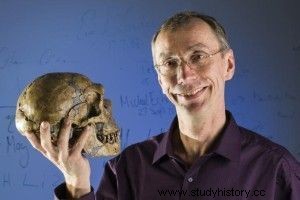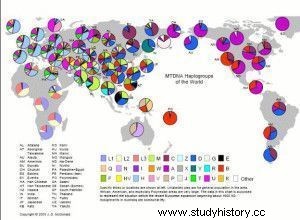But what?  why is it so important to know where we come from? The gestures, the color of the eyes or the shape of the nose are inheritance of our parents; we are as we are because of them and they because of their parents, if we continue pulling the thread we arrive at Adam and Eve and thanks to genetic research, it is possible .
why is it so important to know where we come from? The gestures, the color of the eyes or the shape of the nose are inheritance of our parents; we are as we are because of them and they because of their parents, if we continue pulling the thread we arrive at Adam and Eve and thanks to genetic research, it is possible .
Who are you more like, mom or dad?
In Archeology the same thing happens, but in scientific terms:we need to know if we are more like Homo erectus or the Neanderthal. We want to know that missing link that so much is sought but that, for the moment, is not found. And we are not going to find ourselves suddenly with the missing link, but we will have to chop, dig and break many geological strata to find an answer. The more you dig, the less you keep . This, dear readers, is the handicap of Archeology and at the same time the beauty of it:how to manage to investigate contexts practically destroyed by the passage of time and by geological processes.
Today, we archaeologists have a great deal of progress in our favor to address some of the issues I raised above. From the hand of Russell Higuchi in the magazine Nature we first met ancient DNA (DNA) . Although the researcher par excellence in this area is Svante Pääbo with hundreds of investigations behind him in the search for aDNA hidden in past organisms and rescued by archaeological interventions.

The well-known and famous DNA is the capsule where stores the information genetics and if it is recovered from the past, it may be a major breakthrough in evolutionary research. We can answer to how we were, what we looked like, what cognitive abilities we possessed or what was the turning point for us to become what we are now. But the work of the archaeologist will never be easy, we are not fighting against mummies We didn't even open Pandora's boxes, but even Pandora would have respect when facing an investigation on aDNA.
Recover DNA from thousands of years ago
While we live, our genetic information is intact, but when we die, the DNA deterioration it is extremely fast. The conservation of aDNA in a past organism is practically an achievement in itself, which is why it requires a very strict extraction and analysis methodology.
The first studies on aDNA were carried out on Egyptian mummies. In a 2,700-year-old infant mummy, Pääbo took a sample of the inner tissue of the left thigh and aDNA was found in extremely deteriorated conditions. The sample suffered a degradation process into small fragments that made it difficult to analyze and was very susceptible to contamination with current DNA.
 The instrument with which it is possible to study past genetic information and face the inconvenience of fragmentation is the PCR (polymerase chain reaction). Its mission is simply to photocopy aDNA to be able to compare it with other copies of the same or different species, age, etc. But the issue of contamination still remains, for which it was proposed to extract a DNA sample from all the members of the archaeological team. Since then, given its effectiveness, it has become a regular protocol procedure . It would be like the "Wanted" in archaeology, the sample of all the suspects is collected and if it is contaminated, the culprit will be located.
The instrument with which it is possible to study past genetic information and face the inconvenience of fragmentation is the PCR (polymerase chain reaction). Its mission is simply to photocopy aDNA to be able to compare it with other copies of the same or different species, age, etc. But the issue of contamination still remains, for which it was proposed to extract a DNA sample from all the members of the archaeological team. Since then, given its effectiveness, it has become a regular protocol procedure . It would be like the "Wanted" in archaeology, the sample of all the suspects is collected and if it is contaminated, the culprit will be located.
And all this for what?
After looking through the microscope, the target of our research is the socio-economic, political, geographical and cultural context in which the owner of the sample that we have analyzed developed.
We have already talked about the relevance it suffered in the evolutionary field, but you cannot imagine how useful it is in migratory population movements . This line of research is developed mainly in the American continent to meet the first settlers. The conquests of Christopher Columbus or Americo Vespucci are nothing compared to the theories of settlement through the freezing of the Bering Strait thousands of years before.
The DNAa confirmed that when the strait froze the alien populations to the American continent crossed in search of new places to use resources. It is known because the genetic information contained in current American populations and from an ancestry without high miscegenation such as that of the American Indians determined that there were genetic similarities with populations on the other side of the strait.
 Depending on which part of aDNA we investigate, we will answer different questions. Through the matrilineal line (mother), looking at the mitochondria of the DNA (mitochondrial DNA) revealed that we all came from a single woman, Mitochondrial Eve , with an age of 190,000 years from the African continent. And along the patrilineal line (father), the Y chromosome, of paternal descent and the one that determines male sex by inheritance, was studied, revealed the world origin of a single African man, Chromosomal Adam , with an age of 140,000 years. We already anticipated that if we put on, you could reach Adam and Eve . It wasn't a joke.
Depending on which part of aDNA we investigate, we will answer different questions. Through the matrilineal line (mother), looking at the mitochondria of the DNA (mitochondrial DNA) revealed that we all came from a single woman, Mitochondrial Eve , with an age of 190,000 years from the African continent. And along the patrilineal line (father), the Y chromosome, of paternal descent and the one that determines male sex by inheritance, was studied, revealed the world origin of a single African man, Chromosomal Adam , with an age of 140,000 years. We already anticipated that if we put on, you could reach Adam and Eve . It wasn't a joke.
In addition to discovering that our parents are African and over 150,000 years old , also eliminates at the root the idea of races as they are commonly conceived, since we descend from miscegenation between different lineages with a single origin. Darwin already said it, we all come from the monkey even though we look different. How global genetic information is scientifically related to its geographical location is through DNA haplogroups through independent paternal and maternal lines.

After showing the advantages (and some other drawback) of the studies carried out on aDNA, it is time to worry about the future. Because all research is carried out if it has an encouraging future, and in science that advances with the feet of a giant We can already see what aDNA can offer us.
What future awaits us?
The recent news about the opening of the first world biobank of ancient DNA in Tarragona by the Institut d'Investigacions Biomèdiques August Pi i Sunyer (IDIBAPS), is one of the advances achieved in the genetic field. It will be a step forward in archaeological research and guarantees a future full of new knowledge in the field. And who knows, maybe we can find to the famous missing link or our African mom and dad.
In the end, we are who we are because others were who they were. They will have to be found.
